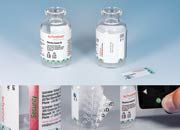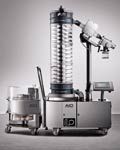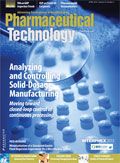Previewing Packaging Innovations
The annual INTERPHEX show presents end-to-end packaging solutions.

Hallie ForcinioWhatever the packaging requirement, chances are there’s a solution waiting at INTERPHEX, the annual pharmaceutical industry trade show scheduled for April 23-25, 2013, at the Javits Center in New York. This year’s show is noteworthy for productivity enhancements, anticounterfeiting technology, and quality control options.
Improved productivity
On a single-rotary tablet press from Fette, the design of the compression stations, drive, turret, and tablet discharge cuts changeover time and improves productivity. For example, turret removal requires no tools and takes only 15 minutes. In addition, upper and lower compression rollers and pressure and position settings adjust automatically by means of commands from the operator interface; operators do not need to make manual adjustments after a turret change. The turret also features a coded tablet scraper and coded filling-cam detection as well as a central, multifunction connector for oil, air, and electricity. Equipped with up to 51 stations, the system produces up to 367,000 tablets per hour. The rotor design also supports quick changeover, maximizes yields, and minimizes product loss. The machine is clad in easily detached, FDA-certified, high-performance polymer panels and offers 360-degree access.
Geometrically optimized surfaces and an integral vacuum system expedite cleaning. User-friendly operator interface provides swift access to the machine’s most important functions via 12 pictogram buttons (FE35 Tablet Press, Fette Compacting America).
A high-performance liquid-filling machine from Cozzoli Machine combines a small footprint with peristaltic pump and single-use technologies. Single-use elements eliminate cleaning, cut costs, hasten setup, and reduce waste. Designed for Class 100 cleanrooms, the fillers rely on existing overhead laminar air flow and may be specified with two, four, six, or eight heads (VR2PP Series liquid fillers, Cozzoli Machine).
A single-use filling system from Filamatic equips a benchtop filler, compatible with a piston, peristaltic, gear, or lobe pump, with a peristaltic pump. In this configuration, fluid flows in a flexible tube fitted inside a circular pump casing. Since the pumped fluid contacts only the inside surface of the disposable tubing, cleanup is quick and easy. The peristaltic pump works best with moderate to large (50 mL to >1100 mL) fill volumes and achieves +/- 1% accuracy (AdaptaFil semiautomatic benchtop filler, Filamatic).
Romaco’s family of liquid filling machines includes six models that handle vials and bottles ranging from 2–500 mL at speeds of up to 200 containers per minute. Features include multiple dosing system and volumetric pump options, adjustable positive container transport for fast changeover, multiple closure stations and cap feeding systems, and programmable setup and recall of product recipes and production parameters. The systems integrate seamlessly with labelers and cartoners (Romaco Macofar LF-200 Series liquid filling machines, MG America, subsidiary of MG2).

Figure 1: Groninger’s aseptic vial-filling line offers contact-free container handling. FIGURE 1 COURTESY OF GRONINGER USAGroninger’s high-speed, aseptic vial-filling line handles 400 vials per minute. Compatibility with time-pressure, rotary piston, and peristaltic pumps increases system flexibility and allows it to fill different products. A vial-handling system eliminates damage and noise associated with glass-to-glass contact (see Figure 1). A three-fold camera checks for glass particles, residues, or deposits inside the vial to prevent contamination of the product and also can inspect filling and closing steps (Kombi Filling Rack on vial filling line, Groninger USA).
A high-speed line from Marchesini Group, capable of filling parenteral products at 400 vials per minute, consists of a rotary washing machine, depyrogenation tunnel, and filling/stoppering machine. The eight-station rotary washer cleans ampules, vials, and other round containers and features quick size-changeover. A modular design accommodates the addition of an ultrasonic prewasher, silicone applicator, heat exchangers, filters, automatic valves, automatic drainers, pressure transmitters, and unloaders to tunnel or tray. The continuous-motion depyrogenation tunnel relies on modular design as well as hot-air flow. A pressurization system independently controls conditions in different sections of the tunnel. Proprietary cooling-zone sterilization cuts cycle time in half. The continuous-motion, in-line filler/capper features an ultra-clean balcony design and is compatible with restricted access barrier systems and isolators, as well as clean- and sterilize-in-place configurations. Other features include contact-free vial handling, camera inspection, and checkweighing. Pump options include peristaltic, time-pressure, and volumetric (WR24 washing machine, Depyr601 tunnel and Stery LC filling/stoppering machine, Marchesini Group).
Anticounterfeiting and tamper evidence

Figure 2: An AlpVision app enables product authentication via smartphone. FIGURE 2 COURTESY OF ALPVISIONSmartphones help fight counterfeiting with an app designed to authenticate products in three seconds. As shown in Figure 2, the phone is positioned over packaging or molded parts to detect and verify covert safety features (e.g., taggants or microprinting, which looks like part of the graphics but reveals a message when examined under magnification). The verification action also can deliver information to the user/consumer about product features, user data, and market (smartphone authentication app for Cryptoglyph and Fingerprint covert safety features, AlpVision).

Figure 3: Schreiner MediPharm’s Pharma-Comb Security Label helps prevent counterfeiting. FIGURE 3 COURTESY OF SCHREINER MEDIPHARMSchreiner MediPharm’s peel-off label for vials now includes a security version with overt and/or covert features to authenticate product and help prevent counterfeiting (see Figure 3). The mix of security elements can be customized and often can be added without changing the label design. Options include overt elements, such as holograms, color-shifting security inks, and guilloche patterns, as well as covert tools, such as voiding effects and LaserSecure, which relies on pigments that only can be “seen” by a dedicated handheld reader. The label also incorporates detachable segments for patient record updating and other purposes. For extra security, removal of detachable sections from the substrate reveals the message, “peel-off part has been removed” (Pharma-Comb Security Label, Schreiner MediPharm).
Another anticounterfeiting tool, a proprietary, two-dimensional barcode from Complete Inspection Systems, matches and verifies GS1 codes printed during packaging operations. The data-intensive barcode can provide information about the location of covert codes used for product authentication (HD P.A.S.S. Barcode Solution, Complete Inspection Systems).

Figure 4: A carton from RondoPak has a tamper-evident design. FIGURE 4 COURTESY OF KÃRBER MEDIPAK.Rondo-Pak’s tamper-evident carton design opens and recloses as easily as a standard folding carton and can be erected and loaded at the same speed as a conventional folding carton (see Figure 4). Perforations cause the lid and dust flaps to tear. The design reportedly surpasses first-opening verification security requirements of the Falsified Medicines Directive 2011/62/EU, which take effect in 2016 (tamper-evident folding carton, Rondo-Pak).
Quality control technology

Figure 5: Pharma Technology’s AIO All In One Deduster and Tester System measures tablet characteristics. FIGURE 5 COURTESY OF PHARMA TECHNOLOGY.A quiet (less than 70 decibels), compact tablet-deduster and testing system from Pharma Technology combines multiple functions such as segmented deduster spirals and metal detector on one base (see Figure 5). The high precision, in-process tablet tester checks weight, hardness, and thickness by sampling at regular intervals and feeds test data to the tablet press for recording into the batch record. Testers can be positioned on three sides of the base and offer push-fit, cable-free connections for power and data storage. A washable, exchangeable deduster module minimizes changeover time (AIO All In One Deduster and Tester System, Pharma Technology).

Drug Solutions Podcast: A Closer Look at mRNA in Oncology and Vaccines
April 30th 2024In this episode fo the Drug Solutions Podcast, etherna’s vice-president of Technology and Innovation, Stefaan De Koker, discusses the merits and challenges of using mRNA as the foundation for therapeutics in oncology as well as for vaccines.